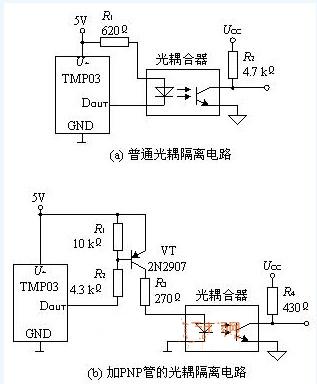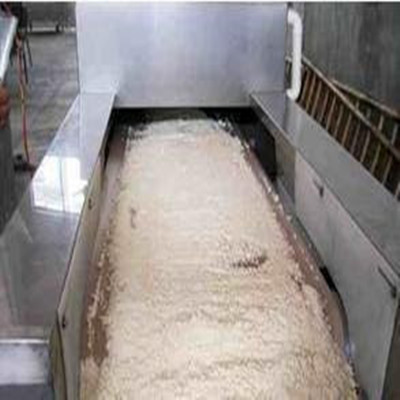(a) The figure shows a common optocoupler isolation circuit. The TMP03 can withstand sink currents below 5 mA and can be directly connected to the cathode of the LED light-emitting diode in the optocoupler. At this time, the pull-up resistor R1 also acts as a current limiting function to prevent LED overcurrent damage. Take R1=620 ohms. When the DOUT terminal is low level, the sink current is less than 1 mA, and the forward voltage drop on the LED is only about 1 V. It should be noted that the optocoupler must be turned on and off exactly the same time, otherwise it will cause errors in the transmitted data. Some Darlington-type optocouplers (such as 4N32) have a much longer turn-on time than the turn-off time and cannot be used here.

(b) One 2N2907 PNP tube has been added to the figure to provide a large operating current for the LED.
(c) An optocoupler using Schmitt shaped output in the figure can reduce transmission noise.

When performing remote temperature measurement, the TMP03/04 is far superior to the analog output temperature sensor. This is because it outputs a digital signal that is more resistant to interference than analog signals. When transmitting signals remotely, the ratio of t 1/t2 must not be affected. If necessary, an ADM485 type RS-485 differential line driver can be added. The circuit is shown in Figure 2. The circuit can accurately transmit temperature signals up to 1200 m away. The lag time error caused by the transmitter and receiver in the ADM485 is only 5 ns, which does not affect the values ​​of t1 and t2. 32 ADM485 can be connected to the RS-485 bus.
PTFE Conveyor Belt is a kind of belt which is non-toxic, non-odor, non-stick surface and suitable for conveying food and food materials.The belt can be used in various power transmission applications, such as drying application, screen print dryers, shrink tunnels.
The belt are known for their long serving life and sturdy construction.
Properties:
·Exceptional strength and dimensional stability
·Operating temperature range from -70℃ to +260℃
·Excellent release properties.
·Low coefficient of friction.
·Easily cleaned.
·Good chemical, moisture and corrosion resistance.
·Good electrical insulation and di-electric properties.
·Food contact approval.



|
Standard Roll Size (mtrs): |
3800mm*250m |
|
mesh size (mm) |
1*1, 2*2, 2*2.5, 4*4, 10*10 |
(Other thickness available upon request)
Conveyor Belt
Conveyor Belt,Teflon Conveyor Belts,Fiberglass Open Mesh Conveyor Belt,Teflon Mesh Conveyor Belt
TAIZHOU YAXING PLASTIC INDUSTRY CO., LTD , https://www.yaxingptfe.com